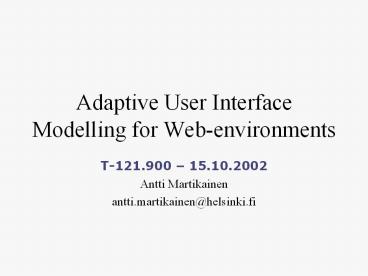Adaptive User Interface Modelling for Webenvironments - PowerPoint PPT Presentation
Title:
Adaptive User Interface Modelling for Webenvironments
Description:
Adaptation based on users behaviour. Rather it is about ... for player: Tiger Woods, David Duval, Phil Mickelson, Mark Calcavecchia... – PowerPoint PPT presentation
Number of Views:124
Avg rating:3.0/5.0
Title: Adaptive User Interface Modelling for Webenvironments
1
Adaptive User Interface Modelling for
Web-environments
- T-121.900 15.10.2002
- Antti Martikainen
- antti.martikainen_at_helsinki.fi
2
Contents
- Requirements for Adaptation
- Device Independent UI Languages
- UI Models
- Model Mapping
- Conclusions
3
Scope
- This presentation is not about
- Intelligence in adaptation
- Adaptation based on users behaviour
- Rather it is about
- Modelling principles to enable a single
application to adapt to different kinds of
devices, and - Finding balance between usability requirements
and development times and maintenance costs
4
Screen resolution
WAP PDA Computer 48x48 256x364 1024x768
5
Adapting applications to devices
- Managing bi-directional interactions requires
device specific adaptation to - Screen resolution
- Connection speed
- Different Markup languages
- Rendering capabilities
- Functional capabilities
6
Language/Device specific capabilities
- Visual rendering
- Colours
- Tables
- Frames
- Images
- Voice detection vs. Visual input
- Scripting capabilities
- Javascript
- Style sheet usage
- CSS (?XSLT)
7
The Common Multi-channel Delivery Mechanism
8
Device Independent UI languages
9
PDA
10
WAP
11
Voice
System "Masters Scores. Please select one of the
following for player Tiger Woods, David Duval,
Phil Mickelson, Mark Calcavecchia..." User
"Tiger Woods." System "Please select one of the
following for Tiger Woods or say "all" to listen
to all of available information Player,
Tournament Score, Round 1, Round 2, Round 3,
Round 4." User "Tournament Score." System "The
Tournament Score for Tiger Woods is 16
under." User "Lookup." System "What information
would you like?" User "Can I have the Round 3
score for Chris DiMarco?" System "The Round 3
score for Chris DiMarco is 69. What information
would you like?" User "Goodbye."
12
Web browser
13
Windows CE
14
Examples of Device Independent UI languages
- UIML (User Interface Markup Language)
- Does not allow implementing device specific
features - MAXML (Multi-channel Access XML)
- Engine implements device specific features
automatically ? designer cannot affect usability
15
Common Problems with Abstract Languages
- Applications built with abstract languages are
either - Implemented to match the capabilities of the
weakest device (lacking required
functionality), or - Not usable, at least concerning some devices
16
User Interface Modelling systems
- UIM languages consist of models
- Task
- Presentation
- Domain
- Device
- Dialogue
- User
17
Task model
- Describes how users do their tasks in a certain
application - Contains the task structure, and the order and
division of interactions between user and system - Formal task descriptions should work as a device
independent starting point for the UI - Task model could support a more straight forward
flow in realizing user requirements in the UI
18
Presentation model
- Represents the visual and auditory elements
provided to the user by the user interface. - Presentation elements give abstract tasks a
concrete form - May also contain stylistic properties, such as
colours and font size - Example
- Define that a persons name is shown in an input
field
19
Domain model
- Defines the underlying objects that the user can
indirectly see and manipulate through the user
interface - Commonly attached to (abstract) task elements to
achieve UI code reuse - Example
- A product has certain attributes These
attributes are managed through certain actions
20
Device model
- Presents the capabilities, such as the used UI
language, connection speeds and other properties
of a device - Example
- Can the device handle JavaScript?
- CC/PP
- W3C standard for device capabilities
- Incomplete
- does not define all necessary elements
- does not say what UIM systems should do with
device properties
21
Dialogue model
- A more concrete approach to task model
- Defines interactions in cases of technical forces
- Example
- How to implement a confirmation, when one device
is Javascript enabled and another is not?
22
User model
- Defines the attributes and roles of users
- Can be used to provide a way to model UI
preferences for specific users or groups of users - Examples
- Exclude a group of users from some task
- Show all possible data attributes to company
management
23
Mapping problem
24
Combining Separate Models
25
Transforming the UI
26
Conclusions
- Model-based UI development strives for
- Systematic and faster UI development with UI code
reuse - Serving all existing devices
- Difficulties
- How to proceed from abstract to concrete UIs
without compromising aesthetic design - Required models and mappings are not completely
clear - Development tools are important (no commercial
products) - New UI design methodology

